Landmand Golf Course, the next King-Collins masterpiece, in the Loess Hills of Eastern Nebraska
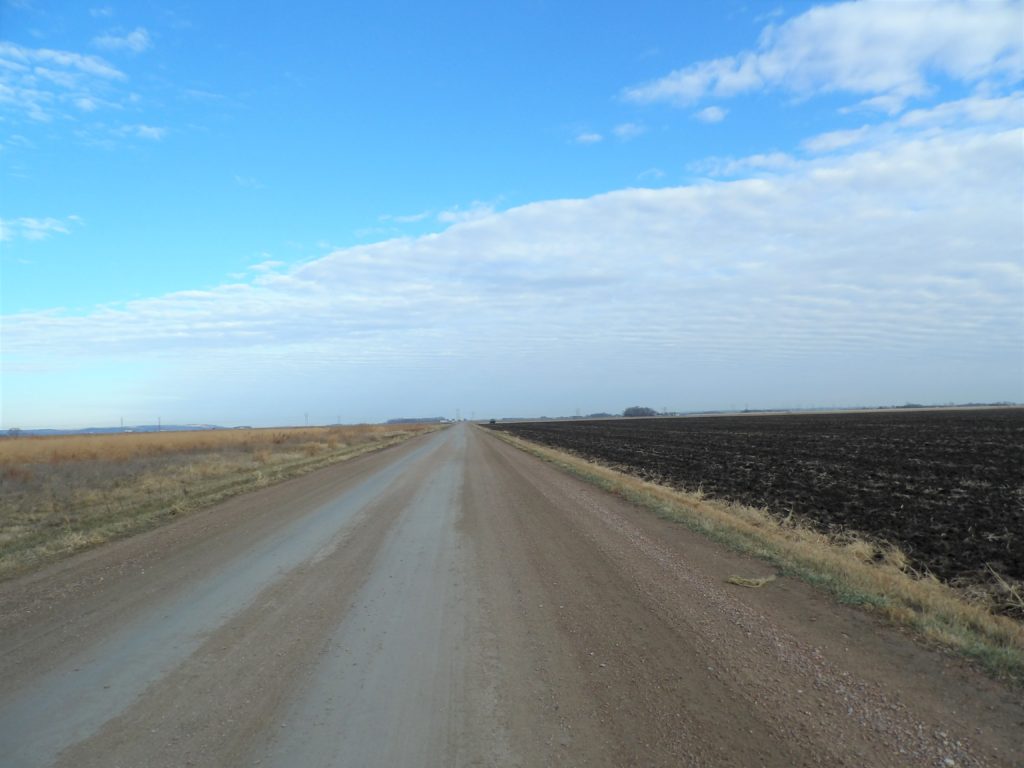
The drive into a golf course can often set the tone for the entire day. It can greatly heighten the sense of anticipation and excitement for what is to follow. There are a few places that are blessed with memorable entry sequences: Machrihanish in Scotland, Sweetens Cove in Tennessee and Ballyneal in Colorado are at the top of my personal list of experiences, all for vastly different reasons. Landmand Golf Course, under construction just outside of Homer, Nebraska, is set to join that list. The four-mile drive along hard-packed gravel roads – through dead flat corn fields – sets the scene perfectly for the day to come. Suddenly the Loess Hills are there, rising abruptly from the alluvial floodplain like the geographical oddity that they are. The white Landmand Barn, sure to become iconic, guards the last stretch of level ground before the Loess formations explode into the sky. You have arrived at a special place.
The Loess Hills of Nebraska are a geological oddity, to paraphrase Ulysses Everett McGill from the classic Coen Brothers film O Brother Where Art Thou? Loess, a loose silicate clay, was deposited by centuries of wind to create these unique landforms in relatively small area of eastern Nebraska and western Iowa. This landscape was supposedly deemed too severe for golf course construction by several leading golf course architects, thus opening up King Collins Golf for their first shot at designing and building an 18 hole course, after many high profile interviews and disappointments. It is an opportunity of a lifetime that is not lost on them. “This is the right project, at the right time for us,” says Rob Collins.
After staying the night in the wonderfully ethnically diverse town of South Sioux City – and following a breakfast of authentic Huevos Rancheros at La Morena restaurant – I made the short drive over to find the site Landmand Gof Course. There is no address. The coordinates are 42o22’02.6”N 96o31’19.7”W. I had been invited to join Rob Collins and Tad King for a tour of the construction site, along with attorney and writer Will Bardwell of Jackson, Mississippi. Having never seen this part of the country, and given the state of the pandemic, I had decided to drive up from north Alabama to Nebraska. It was long, but not unpleasant. Kansas City was a little more than the halfway point on the substantial trek. I met a friend there at the Joe’s Barbeque and was able to stop and see the fabled Brough Creek National, aka Some Guys Backyard. Travel, even in this greatly reduced and hyper-careful Covid dominated world, is still one of the great joys of life. Kansas City barbeque lives up to the hype.
Will arrived at the site shortly after me and we talked about Mississippi and other shared interests for a few minutes, while waiting for Rob and his partner Tad King to arrive. When Rob and Tad pulled in, I jumped in their car and made the relatively long and steep drive up the hill to the 1st tee and future clubhouse area. At the top of the hill, the geographical madness of Landmand fully revealed itself. When The Who’s Pete Townsend wrote “I can see for miles and miles,” no doubt he was not thinking about the Loess Hills of Nebraska – but the song fit this scene perfectly on this cold, brilliantly clear November day. The four of us stood in silence for a few minutes taking in the vista – with Rob walking off to study the horizon alone. The only sound was the constant 20-25 mph wind.
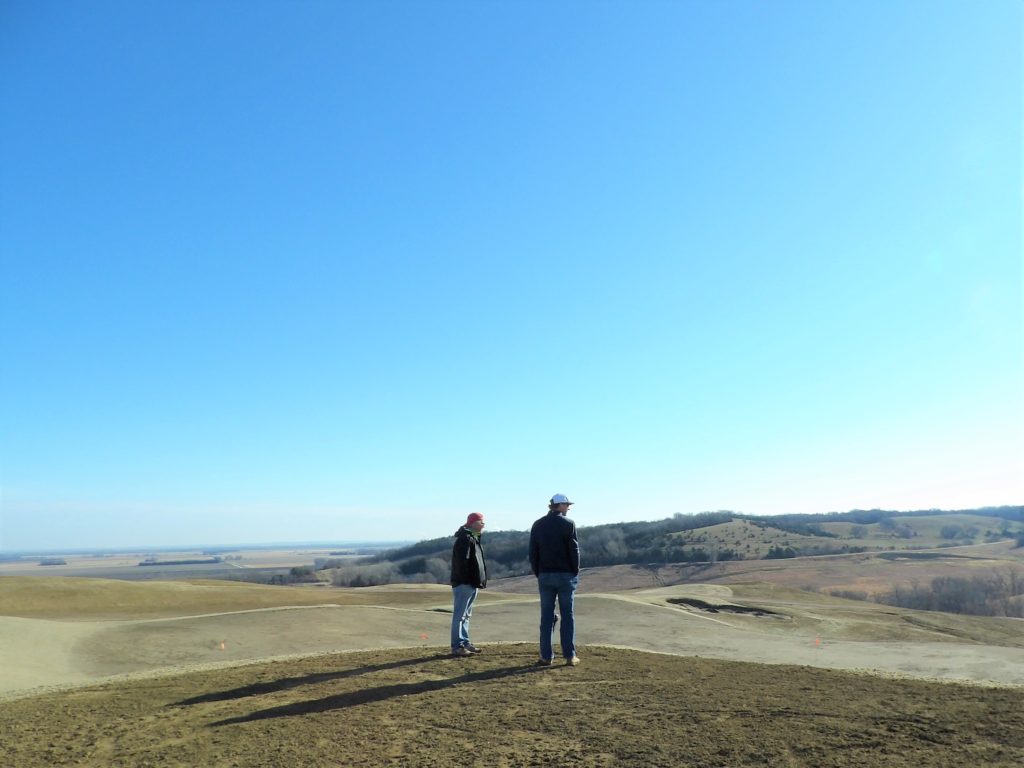
After these few minutes of quiet reflection, Rob was ready to walk the course. John Allen, a friend from Huntsville, Alabama – who had toured the course twice previously with Rob and Tad- had warned me to be prepared for a workout, “Rob flies around that place like a gazelle. You better be ready.” Right off the bat, I knew this was something different – the putting green and 1st tee flow directly into the massive 18th green, which sits off to the left. It is reminiscent in some ways of the tee to green transitions at a place like Elie in Scotland, albeit on a much larger and extensive scale.
Despite the wildness of this terrain and the need to move massive amounts of earth, the sensibilities of classic golf course design remain at the forefront of the design. Collins constantly referenced Alister Mackenzie and Harry Colt as we walked, pointing out seemingly minute design details on every hole. The walks from greens to tees, with one or 2 necessary exceptions, are gloriously short and to the point – like the aforementioned home course of the great architect James Braid. I think it will be expedient – and perhaps unavoidable – to try to compare this course to Ballyneal in Eastern Colorado and Sand Hills in Nebraska, two of the best and deservingly well-known course designs of modern golf architecture. Landmand is something completely different.
I had been advised – again by Mr. Allen – to make sure we carried a range finder for the tour. Once more his advice was well given. The enormous scale of the property plays crazy tricks on the mind and the ability to perceive distance and depth. Looking at the massive bunker in the right corner of the fairway of the par 5 1st hole, Rob pointed out that the best line from the tee is over the bunker. To my eye, even as a trained architect of 30 years used to estimating distances on construction sites, it looked to be at least a 370 yard carry. When Tad measured it with the range finder from where we were standing on the members tee, it was a mere 240 yards. This is well within many golfers abilities, especially with a helping wind. But even if the bold line is not chosen off the tee, there is plenty of room to play safely to the left.
This leads me to one of Rob’s underlying principles as a designer – to create courses that are challenging for a scratch player, but still enjoyable for a 16 handicap. This is infinitely harder to do than it appears on the surface. I maintain that most golfers don’t care nearly as much about their score as they do about being able to have a way to play the course and have fun. Nobody is going to enjoy – much less return – to a place where they lose 15 golf balls. King-Collins Golf understands that and have taken great pains at Landmand to follow this principle. “Our fairways are 100 yards wide here. They have to be,” says Collins.
The drive will be critically important at the first hole, a lovely, slightly uphill par 5 that would not be out of place on Gullane #1 or Shinnecock. A well-struck drive over the aforementioned bunker will likely yield a scoring opportunity. There is a subtleness to the shaping on this hole that fits perfectly into the landscape, like it has been there for 100 years. The green is a wonderful extension of the fairway and allows for the ground approach. The hole sets a welcoming tone, lulling the golfer into a false sense of security for the sheer wildness to come.
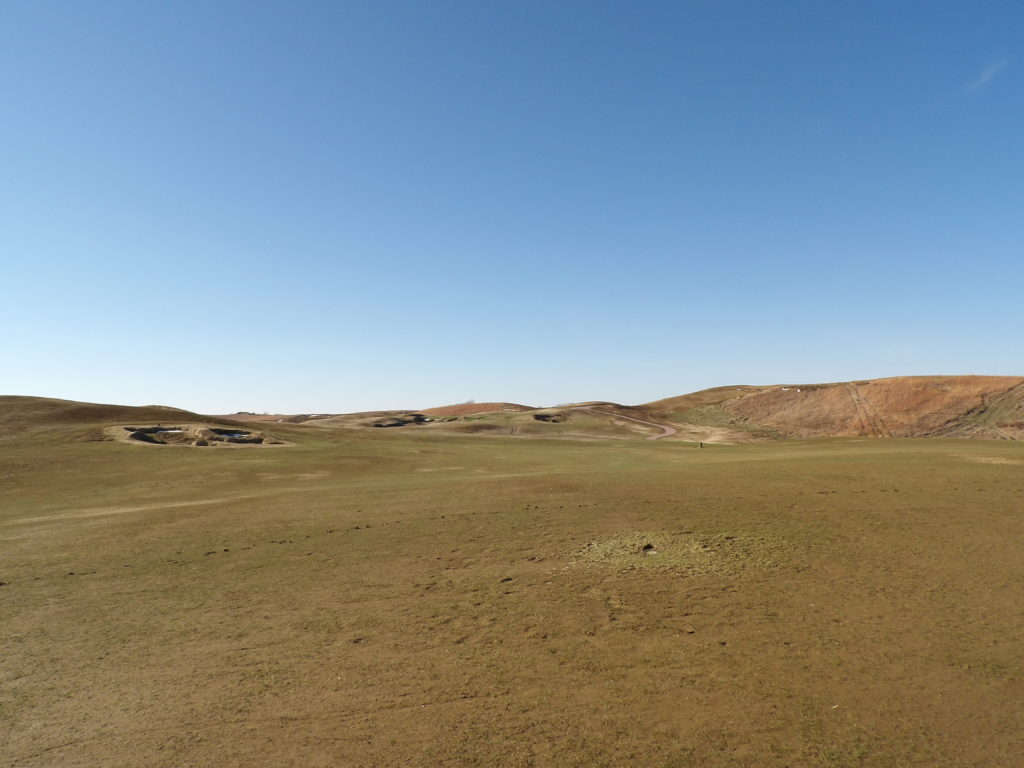
On a course full of great holes, the shortish 360 yard par 4 2nd is one of the standouts. The green is hidden from the teeing ground by the shoulder of a large slope which extends halfway into the wide fairway from the left. A large bunker is located in the middle left of the hill. Should this bunker be carried from the tee, the slope funnels the ball excitedly towards the elegant green. It is reminiscent of the tee shot on the 3rd hole at Cruden Bay in Scotland. It looks to be sheer fun to play and I predict it will be one of the favorite holes on the course.
The slightly uphill par four 3rd and 4th create one of the more unique vistas on the property. A man made drainage barranca, inspired by Los Angeles Country Club and Riviera, splits the fairway on the difficult 3rd, leaving the golfer the option to play left or right of it. There is plenty of fairway on both sides. The left-wing route appears a little easier off the tee, but that portion of the fairway leaves a blind shot into the green. The bolder shot to the right of the barranca – and over a deep bunker – leaves the best angle and a clear view into the green. This combination of the 3rd and 4th holes is a microcosm of the creativity and thought process of King-Collins Golf. The partners were as excited about anything all day as when describing how the barranca subtly wraps around the left hand side of the 3rd green and then continues into the 4th fairway.
The 4th is a 355 yarder and a perfect continuation of the themes of its’ predecessor. There is a safe shot with a 5 iron off the tee or a bolder shot over sand on the left, which I imagine longer hitters will likely challenge the green under the right conditions. Wildness with the driver could also bring the barranca into play, as it continues to snake its’ way up to the right side of the smallish and brilliantly shaped green. Connectivity between design elements throughout the course is a theme that runs throughout the design of King-Collins well-known Sweetens Cove Golf Club. It is obviously once again a key design goal at Landmand
It is tempting to describe every hole at Landmand in detail, but I will focus on my favorite sequences of holes. Every hole laid out on the property ranges from good to great. One of my basic litmus tests of the quality of a golf course is whether or not the golfer can truly remember every hole after playing it for the first time. After walking a 65% completed Landmand GC, I could recall every single hole. I have had this experience before at places like Cruden Bay, Dunaverty, Ballybunion, Royal County Down and others, but it is the exception rather than the rule. To have it occur on a course that is mostly still dirt and Missouri River sand is somewhat remarkable. I replayed the course in my head the entire way back to Alabama the following day.
The sequence of holes starting with the 7th and extending through the 10th is brilliant, all the moreso because the 9th and 10th fall outside of the Loess formations and on the exponentially flatter agricultural ground. Following the practice of Old Tom Morris and James Braid, the basic routing did not take long. “We basically routed this place in a day. We knew where the clubhouse was going to be. We got it all done and the next thing you know we only had 16 holes. We called Will (the owner) and asked him if he owned these corn fields at the southern end of the property. He said ‘yeah, I do”. We asked him if we could put a little golf out there and he said, “sure”, says King.
We were joined on our walk by the owner Will Andersen and 2 of his friends for the start of “Corn Field Corner,” although the 7th and 8th holes are situated in the more theatrical topography. A beautifully shaped 310 yard par 4 with a gathering green site, the 7th will yield birdies and double bogeys in equal measure. Much like the 3rd and 4th, the 8th hole fits perfectly with its’ precursor. A downhill 110 yard par 3 with a smallish green, it invites the golfer to punch a knockdown 8 iron down the slope to the flag. In the strongest wind, that may be the only shot. “It could be the hardest 110 yard shot in golf”, says Collins. This is the essence of golf fun.
The 9th and 10th start the journey into the flatter agricultural land. The 9th is a 420 yard par 4, with its fairway separated from the 10th – another par 4 which runs back parallel in the opposite direction – by a massive waste area bunker. It brings to mind, at least conceptually, the 3rd and 5th holes at Sweetens Cove. The 9th green is fantastically shaped and appears to offer a variety of approach and chipping options. The 10th hole features a drive over a hill shaped out from the Loess formations with a bunker in the face. The line once again is over a bunker, which Collins has placed brilliantly throughout the project to suggest the best line off the tee. A good drive will leave perhaps my favorite approach shot on the course – a short iron into a gigantic punchbowl green that gathers in from all sides. I can’t think of another punchbowl green in the world of this enormous scale. There will be much laughter on this hole.
The designers intend to have the corn planted close enough to encroach into the playing area of 9 and 10, like a golf version of Field of Dreams. When these holes are complete – and the corn is topping out in the summer – you would not be faulted for expecting the ghost of Walter Hagen come striding out of the stalks, looking for a game.
At the long par 5 11th, we start the trek back up into the Loess Hills. The hole features the only tree on the entire course, wisely used to indicate the correct aiming point from the tee. The designers realize this landscape can be disorienting and much thought has gone into providing clues in the distance for the golfer to follow. The hole features a “Hell’s Half-Acre” style bunker, which looks to be very problematic, if not disastrous, should the 2nd shot find its way there. The short walk from the 11th green to the 12th tee follows a path through the greenside bunker. The 12th tee is the high point of the property and the world of Landmand stretches endlessly in the distance. I imagine that many golfers will find a moment to pause here to reflect on the beauty of this stunning landscape.
The 12th is simply a great hole. It is a wonderful plateau to plateau par 3, over a natural chasm to the right. It is like a scaled down version of the famous 14th at Royal Portrush, Calamity. Unlike many holes at Landmand, the 12th did not require much earthwork. “We were riding around in Will’s truck the first time we came out and stopped here. As soon as we looked, we knew this was a hole. It was the first hole we decided on,” says King. The green appears to be a postage stamp from the tee, with the surface barely visible behind the wonderful bunkering. However, like many things at Landmand, it is revealed to be deceptively larger once the surface is reached. “You just have to hit a good tee shot here,” says Collins, “that’s really the only choice.”

The 13th is a naturally sloping 450 yard downhill par 4 that should play much shorter than its yardage. It is admittedly intended to be a breather before the wild finish to come. This final crescendo starts with the 240 yard par 3 14th, a true Redan style hole. It will be one of the more talked about holes at Landmand. Almost two-thirds of the massive green is banked at a true Redan slope. The only way to get to the potential flag locations is to play off the Redan. The fairway has been shaped to allow for shorter hitters to run it up the right-hand side to access the slope. The bunkering around this green is stunning. This is one of the top 5 holes on the course.
Walking down from the par 5 15th tee to reach the fairway, it becomes apparent how much earth has been moved to create a golf course here. At least 30 feet of fill material was placed to create a manageable transition from the 15th tee site to the fairway. If you are not familiar with earthwork, this is a massive amount of dirt. However, like everything else on site, it looks natural. This is a testament to the skill of the designers and shapers. The 16th hole is a long and difficult 495 yard par 4, with a natural canyon to the right from which there is no return.
Standing on the 16th green, Rob pointed out something to me that perfectly demonstrates his design philosophy. There had been a large hill blocking the view from the 16th green to the “Sitwell” style green in the distance on the 310 yard par 4th 17th hole. “We shaped a bunch of dirt so that you would have a view of the 17th green from this spot. I want people to have a sort of preview of that green before they get to the tee,” Collins says. It is this level of detail and artistic thought that is going to make Landmand one of the best, if not the best, truly public golf courses in the United States. I exclude “public” golf courses that cost $580 a round from this discussion. Will Andersen and his family are to be commended for promoting public access golf of this extraordinary level of quality.
The 17th is a brilliant and fun match play hole, with the approximately 30,000 square foot “Sitwell” inspired green offering more flag locations that I can imagine. The tee shot sets up the hole, with the decision based once again on a center line bunker. The 510 yard par 5 18th has a wonderfully blind tee shot and takes us back up to the semi-plateau world of the 1st, 18th, putting green and the future clubhouse. The 18th and 1st are 2 interlocking parts of the same puzzle, a King Collins trademark. The 18th offers a chance at a closing birdie and perhaps the thought of an enjoyable pint in the clubhouse. The green is dramatically bunkered and has the chance to be one of the best on the course, once the master Tad King starts to work his final green shaping magic next spring.
Without realizing it, we had spent almost an entire day walking Landmand Golf Course. An old man like me should have been exhausted, but I was energized by what I had just seen. Seeing artwork in progress – which great golf course design most assuredly is – is strangely exhilarating. As we started to get back in Rob’s rental car for the drive down back the hill to the barn, Tad King stopped and turned back to the course, “Have a nice winter, Landmand. See you in the spring,” he said happily. As we got in the car, Led Zeppelin’s Going to California was on the radio. It seemed strangely appropriate:
“Standing on a hill in my mountain of dreams,
Telling myself it’s not as hard, hard, hard as it seems.”
The road to success – kept alive by the fruit-bearing tree of Sweetens Cove Golf Club – has been long and hard for King-Collins Golf. They have persevered with intense self-belief. Landmand is their mountain of dreams.
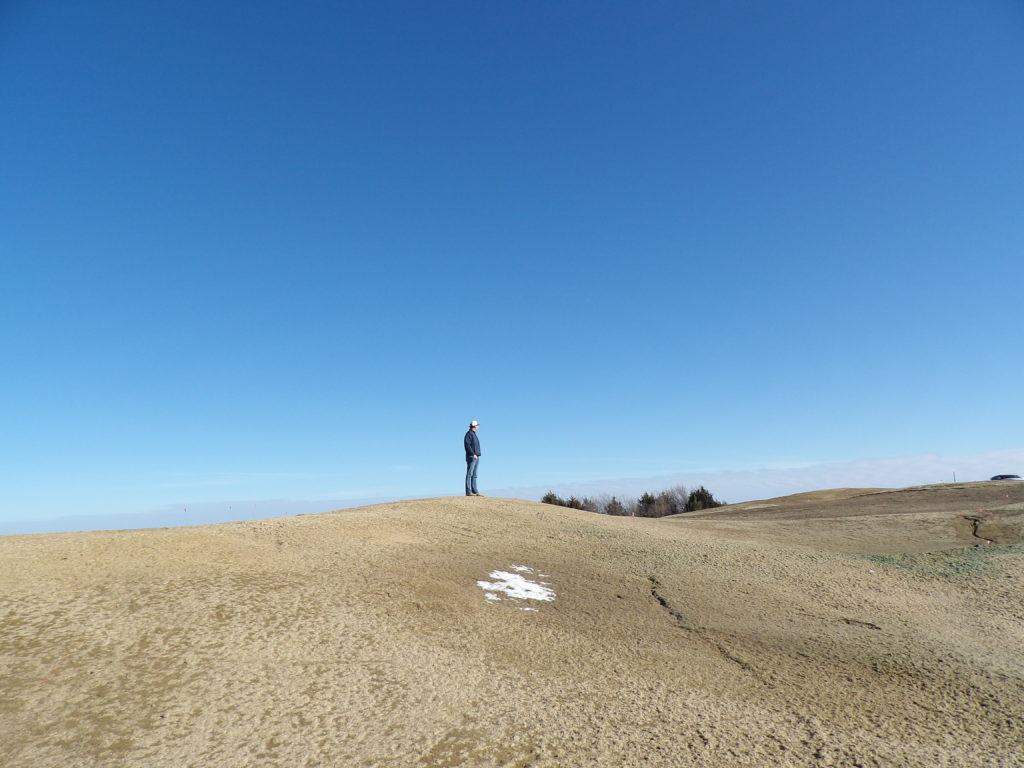
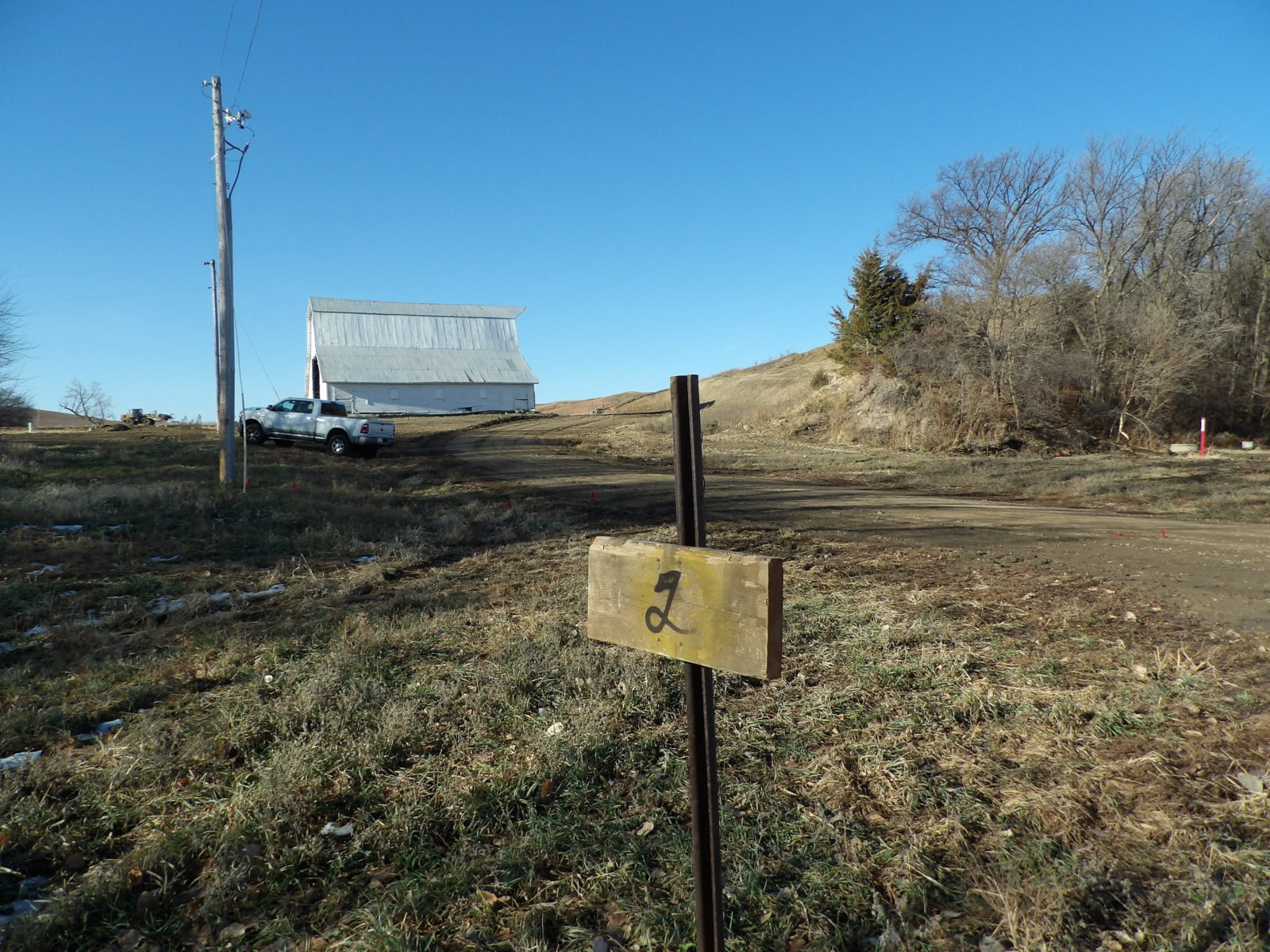
Great article Jim, I appreciate your zest for golf and l’m envious your ability to paint a picture with words. I you’re ever in SW Missouri I would love to show you our facilities here at Big Cedar, even if it isn’t on the same plane as the natural old world inspired golf of which you write and King Collins are creating.
Yours in golf
Steve Johnson, CGCS
Thank you for reading Steve!
What a day! And what a tease!
You highlighted the gigantic scale of the property, but did the guys disclose the actual size of the course? Of the routing footprint?
Thanks Jim.
David
Thank you for reading.
I do have a copy of the routing. Its pretty accurate but has changed a little as they have built it. The course is not crazy long. I think its right at 7,000 from the tips. And the walks between greens and tees are all nice and short. There is one sort of long uphill one but other than that its very Scottish in that regard. That said, its a tough walk.
Jim
Well written, Jim!
Thank you Brent
If google maps are correct, it looks like a little over 15 hours of drive time from Birmingham to Homer, NE. Looks like a plan to me. Looking forward to seeing the progress along the way.
Its a long way, Mark.
Jim,
Thoroughly enjoyed your story of Landmand, detailed, informational and entertaining to read. Can’t wait to get out there to play it when it opens!
Thanks for sharing!
Thank you for reading Gregg. I really appreciate it
Brilliant. I am ready to tee it up. It sounds like a fantasy.
Scott
I think it will be great. I imagine there will be some people that dont like it but they will be in the vast minority. Thank you for reading. I really appreciate it.
Jim
Outstanding article. I have been enamored with Landmand since I first heard of it over a year ago. I can’t wait to play it even more after reading this.
Thank you for reading. Its going to be an exciting place to visit.
I could run through a wall after reading this! Nebraska here I come!
LOL. Thank you for reading. Its going to be exciting when it opens.